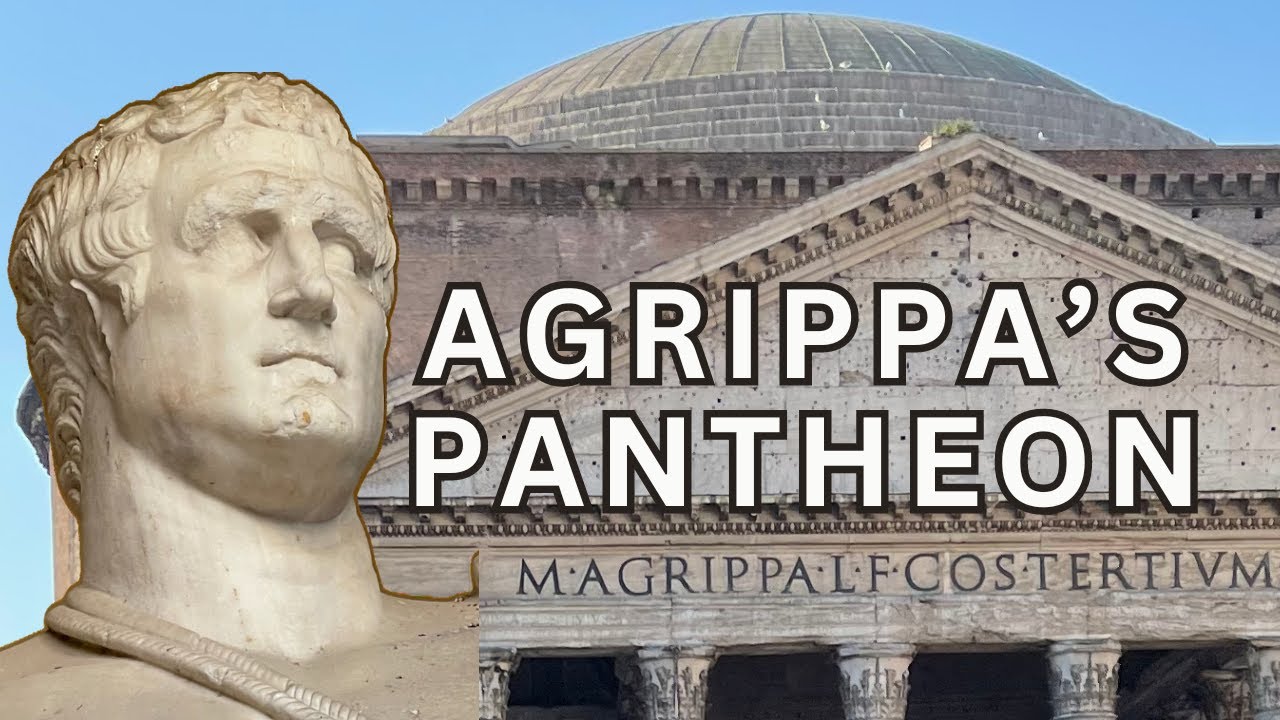Start with our video overview:
The Pantheon of Agrippa was an ancient Roman temple dedicated to all the major gods of Rome. Its name is derived from the Greek pan meaning “all” and theon meaning “gods.” The temple burned down multiple times throughout its history, and the version we see today was built under the emperor Hadrian.
The original Pantheon was built in 25 BCE during the reign of Augustus, Rome’s first emperor, and the third consulship of Marcus Vipsanius Agrippa. Agrippa was a trusted lieutenant and close friend of Augustus, and he oversaw the building’s construction. The original Pantheon would maintain the same proportions and dimensions throughout the many phases of its existence, consisting of a large, north-facing porch and a rotunda. The direction of the porch was deliberate, as it aimed directly across the Campus Martius at the Mausoleum of Augustus. This emphasized Augustus and his connection to the divine, and in a way, placed him among the pantheon of the gods. Despite this bold statement, Augustus demonstrated great piety by refusing to have his statue placed inside the temple. It was only after his death and deification that his statue was finally added. Nevertheless, a statue of Julius Caesar, his deified adopted father, and a statue of the goddess Tyche were placed inside the temple. Tyche was the Greek goddess of chance and the protector of the righteous, often associated with giving leaders their right to rule. Through the placement of these statues, Augustus paid homage to the divine forces responsible for his reign.
A distinctive architectural feature of the Pantheon of Agrippa was its caryatids, which were used in place of columns. The design of these caryatids was based on those used in the Erechtheion in Athens. Although the Roman copies were smaller than the originals, they were made of bronze, emphasizing the wealth of the Augustan regime. The roof of Agrippa’s Pantheon was likely made of wooden truss work, deriving its style from the Diribitorium, a voting hall also built by Agrippa. The Pantheon was destroyed by fires in 80 CE and 110 CE. It was completely rebuilt under emperor Hadrian, who kept the original inscription (dedicated to Agrippa) but added a new roof consisting of a massive free-standing dome. Two thousand years later, the Pantheon is still the largest unreinforced concrete dome in the world.
The Pantheon maintains such a rich history because of how well it has been preserved. Centuries after the fall of the Western Roman Empire, Pope Boniface IV moved the bodies of Christian martyrs into the temple, converting it into a church. This action required the temple to be regularly maintained in ways that other ancient Roman monuments were not, resulting in the Pantheon being the best-preserved Roman temple from antiquity.
Bibliography
- Grout, James. “Pantheon.” University of Chicago. https://penelope.uchicago.edu/~grout/encyclopaedia_romana/romanurbs/pantheon.html
- Schultz, Colin. “Why the Pantheon Hasn’t Crumbled.” Smithsonian Magazine. https://www.smithsonianmag.com/smart-news/scientific-reason-why-pantheon-hasnt-crumbled-180953627/
- “Tyche.” Encyclopedia Britannica. https://www.britannica.com/topic/Tyche
This content is brought to you by The American Institute for Roman Culture, a 501(C)3 US Non-Profit Organization.
Please support our mission to aid learning and understanding of ancient Rome through free-to-access content by donating today.
Cite This Page
Cite this page as: Darius Arya, The American Institute for Roman Culture, “Pantheon of Agrippa” Ancient Rome Live. Last modified 04/19/2024. https://ancientromelive.org/pantheon/
License
Created by The American Institute of Roman Culture, published on 04/19/2024 under the following license: Creative Commons: Attribution-NonCommercial-ShareAlike. This license lets others remix, tweak, and build upon this content non-commercially, as long as they credit the author and license their new creations under the identical terms. Please note that content linked from this page may have different licensing terms.



